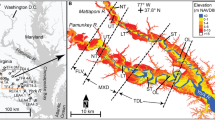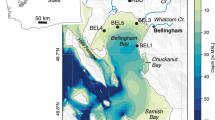Abstract
Hydrographic measurements of salt wedge structure and dynamics spanning a 20-fold seasonal range of river discharges are used to investigate the seasonal variability in the strongly stratified Duwamish River Estuary. The effect of river discharge on salt wedge length, stratification, pycnocline thickness, and intratidal differences in salinity structure are evaluated. The salt wedge decreases in length and becomes more stratified as river discharge increases. The ebb and flood responses to increasing discharge are markedly different; the flood phase structure shows little seasonal dependence, while the ebb structure changes due to an internal hydraulic response that is strongest at two severe lateral constrictions. This response varies with the net barotropic forcing, which is controlled by river discharge. The asymmetry between the structure on ebb and flood is explained using a two-layer hydraulic framework, although spatially, tidally, and seasonally variable vertical mixing also modifies the structure. As a result of the persistent stratification and dominance of hydraulic dynamics, channel constrictions influence circulation and transport during ebb tides. These dynamics also generate a flood/ebb asymmetry in salt wedge structure and circulation that is modulated seasonally through discharge. We hypothesize that these dynamics lead to a seasonally modulated residual circulation.













Similar content being viewed by others
References
Armi, L., and D.M. Farmer. 1986. Maximal two-layer exchange through a contraction with barotropic net flow. Journal of Fluid Mechanics 164: 27–51.
Burchard and Baumert. 1998. The formation of estuarine turbidity maxima due to density effects in the salt wedge. A hydrodynamic process study. Journal of Physical Oceanography 28 (2): 309–321.
Chant, R.J., and R.E. Wilson. 2000. Internal hydraulics and mixing in a highly stratified estuary. Journal of Geophysical Research: Oceans 105: 14215–14222.
Chatwin, P. 1976. Some remarks on the maintenance of the salinity distribution in estuaries. Estuarine and Coastal Marine Science 4 (5): 555–566.
Chawla, A., D.A. Jay, A.M. Baptista, M. Wilkin, and C. Seaton. 2008. Seasonal variability and estuary–shelf interactions in circulation dynamics of a river-dominated estuary. Estuaries and Coasts: 269–288.
Dawson, W., and L. Tilley. 1972. Measurement of salt-wedge excursion distance in the Duwamish River estuary, Seattle, Washington, by means of the dissolved-oxygen gradient.
De Nijs, M.A.J., J.D. Pietrzak, and J.C. Winterwerp. 2011. Advection of the salt wedge and evolution of the internal flow structure in the Rotterdam waterway. Journal of Physical Oceanography 41 (1): 3–27.
Farmer, D.M., and L. Armi. 1986. Maximal two-layer exchange over a sill and through the combination of a sill and contraction with barotropic flow. Journal of Fluid Mechanics 164: 53–76.
Fischer, H.B. 1972. Mass-transport mechanisms in partially stratified estuaries. Journal of Fluid Mechanics 53 (4): 671–687.
Friedrichs, C., and D. Aubrey. 1994. Tidal propagation in strongly convergent channels. Journal of Geophysical Research 99 (C2): 3321–3336.
Gardner, J.S., and J.D. Smith. 1978. Turbulent mixing in a salt wedge estuary. In Hydrodynamics of estuaries and fjords: proceedings of the 9th international Liege colloquium in ocean hydrodynamics, 1977, ed. J.C.J. Nihoul, 79–106. Amsterdam: Elsevier oceanography Series.
Geyer, W.R. 1988. The advance of a salt wedge front: Observations and dynamical model. In Physical Processes in Estuaries, ed. J. Dronkers and W. van Leussen, 181–195.
Geyer, W., and D. Farmer. 1989. Tide-induced variation of the dynamics of a salt wedge estuary. Journal of Physical Oceanography: 1060–1072.
Geyer, W.R., and D.K. Ralston. 2011. The dynamics of strongly stratified estuaries. Treatise on Estuarine and Coastal Science: 37–52 Elsevier Inc.
Geyer, W., and J. Smith. 1987. Shear instability in a highly stratified estuary. Journal of Physical Oceanography JPYOBT
Geyer, W.R., D.K. Ralston, and R.C. Holleman. 2017. Hydraulics and mixing in a laterally divergent channel of a highly stratified estuary. Journal of Geophysical Research 122: 4743–4760.
Giddings, S.N., D.A. Fong, and S. Monismith. 2011. Role of straining and advection in the intratidal evolution of stratification, vertical mixing, and longitudinal dispersion of a shallow, macrotidal, salt wedge estuary. Journal of Geophysical Research C03003.
Giddings, S.N., S.G. Monismith, D.A. Fong, and M.T. Stacey. 2014. Using depth-normalized coordinates to examine mass transport residual circulation in estuaries with large tidal amplitude relative to the mean depth. Journal of Physical Oceanography 44 (1): 128–148.
Hansen, D., and M. Rattray. 1965. Gravitational circulation in straits and estuaries. Journal of Marine Research 23: 104–122.
Hansen, D.V., and M. Rattray. 1966. New dimensions in estuary classification. Limnology and Oceanography 11 (3): 319–326.
Harleman, D.R.F. 1961. Stratified flow. In The handbook of fluid dynamics, ed. V.L. Streeter, 26.1–26.21. McGraw-Hill.
Jay, D.A. 1987. Residual circulation in shallow stratified estuaries. School of Oceanography, University of Washington.
Jay, D.A., and J.D. Musiak. 1994. Particle trapping in estuarine tidal flows. Journal of Geophysical Research 99 (C10): 20 445–461.
Jay, D.A. and J.D. Musiak. 1996. Internal tidal asymmetry in channel flows: origins and consequences. In Mixing Processes in Estuaries and Coastal Seas. C. B. Pattiaratchi, Ed., Coastal and Estuarine Studies Series, Vol. 50, Americal Geophysical Union, 211–249.
Jay, D.A., and J.D. Smith. 1990a. Residual circulation in shallow estuaries part 1. Highly stratified, narrow estuaries. Journal of Geophysical Research. 95 (C1): 711–731.
Jay, D.A., and J.D. Smith. 1990b. Circulation, density distribution and neap-spring transitions in the Columbia River estuary. Progress in Oceanography. 25 (1-4): 81–112.
Lower Duwamish Waterway Group [LDWG]. 2010. Final Remedial Investigation Report.
MacCready, P., and W.R. Geyer. 2010. Advances in estuarine physics. Annual Review Marine Science 2 (1): 35–58. https://doi.org/10.1146/annurev-marine-120308-081015.
MacDonald, D.G., and A.R. Horner-Devine. 2008. Temporal and spatial variability of vertical salt flux in a highly stratified estuary, Journal of Geophysical Research: C09022.
Miles, J.W. 1961. On the stability of heterogeneous shear flows. Journal of Fluid Mechanics 10 (04): 496–508.
Orton, P.M., and M. Visbeck. 2009. Variability of internally generated turbulence in an estuary, from 100 days of continuous observations. Continental Shelf Research 29 (1): 1859–1877.
Partch, E.N., and J.D. Smith. 1978. Time dependent mixing in a salt wedge estuary. Estuarine and Coastal Marine Science 6 (1): 3–19.
Peters, H. 2003. Broadly distributed and locally enhanced turbulent mixing in a tidal estuary. Journal of Physical Oceanography 33 (9): 1967–1977.
Poggioli, A.R., and A.R. Horner-Devine. 2015. The sensitivity of salt wedge estuaries to channel geometry. Journal of Physical Oceanography 45 (12): 3169–3183.
Ralston, D.K., W.R. Geyer, and J.A. Lerczak. 2010a. Structure, variability, and salt flux in a strongly forced salt wedge estuary. Journal of Geophysical Research: Oceans 115 (C6).
Ralston, D.K., W.R. Geyer, J.A. Lerczak, and M. Scully. 2010b. Turbulent mixing in a strongly forced salt wedge estuary. Journal of Geophysical Research: Oceans 115 (C12).
Rattray, M., and E. Mitsuda. 1974. Theoretical analysis of conditions in a salt wedge. Estuarine and Coastal Marine Science 2 (4): 375–394.
Ross, D.A. 1995. Introduction to oceanography. New York: Harper Collins College Publishers.
Santos, J., and J. Stoner. 1972. Physical, chemical, and biological aspects of the Duwamish River estuary, King County, Washington, 1963-67. csa.com.
Schijf, J.B. and Schönfled, J.C., 1953. Theoretical considerations on the motion of salt and fresh water. In Proceedings Minnesota International Hydraulic Convention. IAHR.
Stenström, P. 2004. Hydraulics and mixing in the Hudson River estuary: A numerical model study of tidal variations during neap tide conditions. Journal of Geophysical Research: Oceans 109 (C4).
Stoner, J. 1967. Prediction of salt-water intrusion in the Duwamish River estuary, King County, Washington. Geological Survey Research: D253–D255.
Acknowledgments
The authors acknowledge that the Duwamish River runs through the ancestral lands of the Duwamish Indian Tribe and honor the traditional land and water of the Coast Salish Peoples on which this work took place. We are grateful for the many, many volunteers who provided help in the field, in particular, P. Clayton, J. Wilson, the UW EFM group, and 36 ambitious undergraduate fluid dynamics students. We also thank the 2012 FHL Estuarine and Coastal Fluid Dynamics class, in particular P. MacCready, W.R. Geyer, K. Arnott, J. Lopez, A. Tabatabai, S. Warner, and M. Williams. We also thank A. Ogston, C. Nittrouer, J. Thompson, A. Jessup, and Gravity Environmental LLC for the use of vessels and equipment, and the South Park Marina and Shumate Family for the use of their facilities. Larry Armi provided valuable input on the two-layer hydraulics. Additionally, we thank three anonymous reviewers who were instrumental in improving this manuscript. This research was supported by the University of Washington Royalty Research Fund, the Sea-Bird Electronics Student Equipment Loan Program, and the Amherst College Graduate School Fellowship Program. ARHD was supported by the Allan and Inger Osberg Professorship.
Author information
Authors and Affiliations
Corresponding author
Additional information
Communicated by Arnoldo Valle-Levinson
Rights and permissions
About this article
Cite this article
McKeon, M.A., Horner-Devine, A.R. & Giddings, S.N. Seasonal Changes in Structure and Dynamics in an Urbanized Salt Wedge Estuary. Estuaries and Coasts 44, 589–607 (2021). https://doi.org/10.1007/s12237-020-00788-z
Received:
Revised:
Accepted:
Published:
Issue Date:
DOI: https://doi.org/10.1007/s12237-020-00788-z




